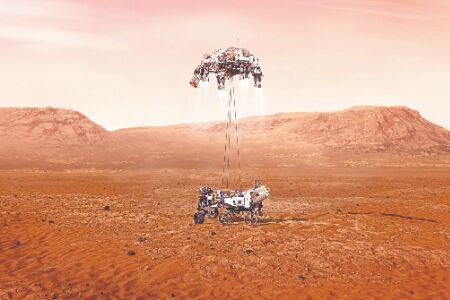Next stop Mars: 3 spacecraft arriving in quick succession

Cape Canaveral: After hurtling hundreds of millions of miles through space since last summer, three robotic explorers are ready to hit the brakes at Mars.
The stakes - and anxiety - are sky high.
The United Arab Emirates' orbiter reaches Mars on Tuesday, followed less than 24 hours later by China's orbiter-rover combo. NASA's rover, the cosmic caboose, will arrive on the scene a week later, on Feb. 18, to collect rocks for return to Earth - a key step in determining whether life ever existed at Mars.
Both the UAE and China are newcomers at Mars, where more than half of Earth's emissaries have failed. China's first Mars mission, a joint effort with Russia in 2011, never made it past Earth's orbit.
We are quite excited as engineers and scientists, at the same time quite stressed and happy, worried, scared, said Omran Sharaf, project manager for the UAE.
All three spacecraft rocketed away within days of one another last July, during an Earth-to-Mars launch window that occurs only every two years. That's why their arrivals are also close together.
Called Amal, or Hope in Arabic, the Gulf nation's spacecraft is seeking an especially high orbit - 13,500 by 27,000 miles high (22,000 kilometers by 44,000 kilometers) - all the better to monitor the Martian weather.
China's duo - called Tianwen-1, or Quest for Heavenly Truth - will remain paired in orbit until May, when the rover separates to descend to the dusty, ruddy surface. If all goes well, it will be only the second country to land successfully on the red planet.
The US rover Perseverance, by contrast, will dive in straight away for a harrowing sky-crane touchdown similar to the Curiosity rover's grand Martian entrance in 2012. The odds are in NASA's favor: It's nailed eight of its nine attempted Mars landings.
Despite their differences - the 1-ton Perseverance is larger and more elaborate than the Tianwen-1 rover - both will prowl for signs of ancient microscopic life.
Perseverance's 3 billion mission is the first leg in a US-European effort to bring Mars samples to Earth in the next decade.
To say we're pumped about it, well that would be a huge understatement, said Lori Glaze, NASA's planetary science director.
Perseverance is aiming for an ancient river delta that seems a logical spot for once harboring life. This landing zone in Jezero Crater is so treacherous that NASA nixed it for Curiosity, but so tantalizing that scientists are keen to get hold of its rocks.
When the scientists take a look at a site like Jezero Crater, they see the promise, right? said Al Chen, who's in charge of the entry, descent and landing team at NASA's Jet Propulsion Laboratory in Pasadena, California.
When I look at Jezero, I see danger. There's danger everywhere.
Steep cliffs, deep pits and fields of rocks could cripple or doom Perseverance, following its seven-minute atmospheric plunge. With an 11 1/2-minute communication lag each way, the rover will be on its own, unable to rely on flight controllers. Amal and Tianwen-1 will also need to operate autonomously while maneuvering into orbit.



